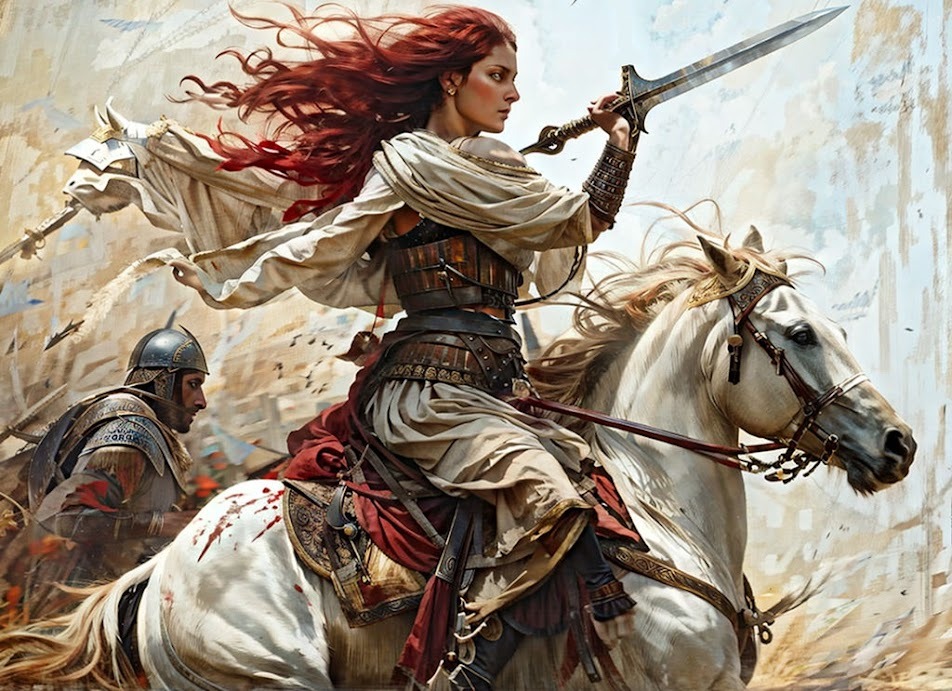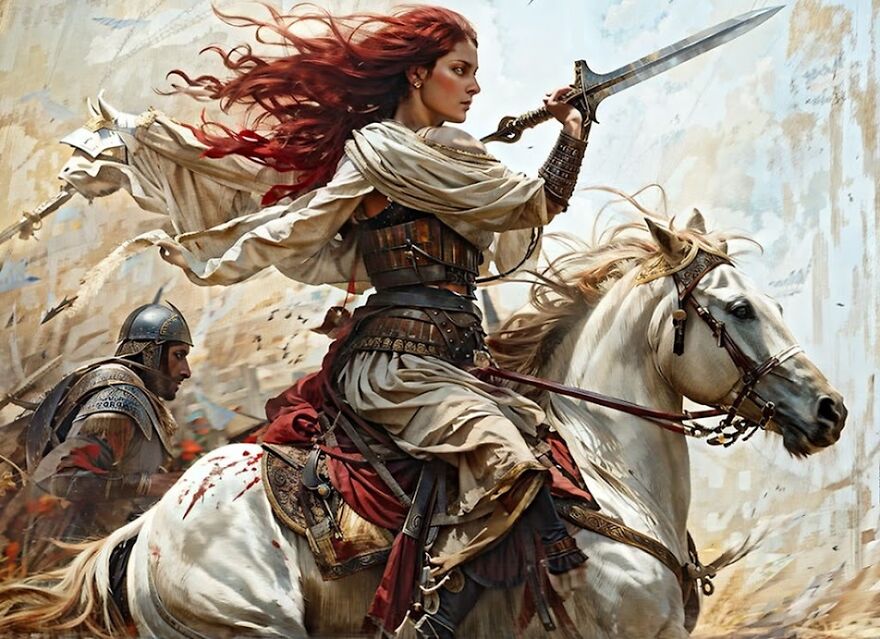
01 Work, The Art Of War, Leonardo Da Vinci’s Alma’s Triumph At The Battle Of Anghiari, With Footnotes
The Battle of Anghiari was fought on 29 June 1440, between the forces of Milan and the League of some Italian states led by the Republic of Florence in the course of the Wars in Lombardy. The battle was a victory for the Florentines, who secured their domination of central Italy. More on The Battle of Anghiari
“Alma’s Triumph at The Battle of Anghiari” is a powerful and captivating depiction inspired by Leonardo da Vinci’s famous artwork, “The Battle of Anghiari.” This reimagination showcases Alma, a remarkable Bedouin warrior woman, as she fearlessly fights against her attackers on the battlefield.
Clad in Arab armor, Alma stands out amidst the chaos, her appearance marked by the physical toll of the ongoing conflict. Mud and blood cover her legs, arms, and midriff, bearing witness to the arduous nature of the battle she has endured. A veneer of weariness overlays her battle-hardened spirit, a testament to her unyielding determination to protect her people and land.
Mounted atop her majestic Arabian stallion, Alma exudes both grace and strength. Her posture suggests unwavering resolve as she raises her sword, poised to strike at her adversary. The anticipation and focus in her expression reveal her combat prowess and the expertise honed through countless battles.
The scene is painted with intensity and dynamism, capturing the frenzy and violence of war. The disarrayed battlefield, with its chaotic blend of charging horses, flailing weapons, and billowing battlefield dust, adds to the immersive quality of the artwork. Alma’s figure stands out amidst the flurry of action.
Through this portrayal, the artist pays tribute to the fierce and valiant nature of Alma, an embodiment of the Bedouin warrior tradition. Alma symbolizes the strength and resilience of the Arab people, willing to fight against all odds.
The painting’s color palette reflects the intensity of the battle. Warm tones dominate the scene, representing the fire and passion that drives Alma’s unwavering commitment to her cause. The contrast of vibrant reds against desaturated grays and browns heightens the drama and adds depth to the composition.
This artwork, through its depiction of Alma’s triumph, becomes a timeless representation of the indomitable spirit and heroism exhibited by women warriors throughout history. It reminds viewers of the significance of honoring those who, against all odds, rise above adversity and fight for what they believe in.
Leonardo da Vinci, (born April 15, 1452, Anchiano, near Vinci, Republic of Florence — died May 2, 1519, Cloux, France), Italian painter, draftsman, sculptor, architect, and engineer whose genius, perhaps more than that of any other figure, epitomized the Renaissance humanist ideal. His Last Supper (1495–98) and Mona Lisa (c. 1503–19) are among the most widely popular and influential paintings of the Renaissance. His notebooks reveal a spirit of scientific inquiry and a mechanical inventiveness that were centuries ahead of their time.
The unique fame that Leonardo enjoyed in his lifetime and that, filtered by historical criticism, has remained undimmed to the present day rests largely on his unlimited desire for knowledge, which guided all his thinking and behaviour. An artist by disposition and endowment, he considered his eyes to be his main avenue to knowledge; to Leonardo, sight was man’s highest sense because it alone conveyed the facts of experience immediately, correctly, and with certainty. Hence, every phenomenon perceived became an object of knowledge, and knowing how to see became the great theme of his studies. He applied his creativity to every realm in which graphic representation is used: he was a painter, sculptor, architect, and engineer. But he went even beyond that. He used his superb intellect, unusual powers of observation, and mastery of the art of drawing to study nature itself, a line of inquiry that allowed his dual pursuits of art and science to flourish. More Leonardo da Vinci
Please visit my other blogs: Art Collector, Mythology, Marine Art, Portrait of a Lady, The Orientalist, Art of the Nude and The Canals of Venice, Middle East Artists, 365 Saints, 365 Days, and Biblical Icons, also visit my Boards on Pinterest and deviantart
Images are copyright of their respective owners, assignees or others. Some Images may be subject to copyright
I don’t own any of these images – credit is always given when due unless it is unknown to me. if I post your images without your permission, please tell me.
Ads are shown only to compensate the hosting expenses.
If you enjoyed this post, please share with friends and family.
Thank you for visiting my blog and also for liking its posts and pages.
Please note that the content of this post primarily consists of articles available from Wikipedia or other free sources online.


 Dark Mode
Dark Mode 

 No fees, cancel anytime
No fees, cancel anytime 


























-1
0